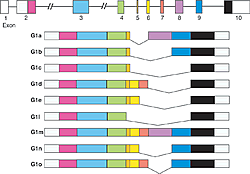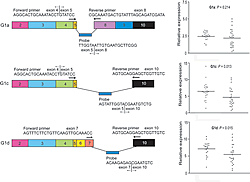Background
Schizophrenia, a mental disorder that usually strikes in adolescence, affects approximately 1% of the population. Lesions in the brain that occur during development are strongly suspected to affect how the mature brain responds to stimuli and thereby contribute to this disorder. Therefore, it is likely that polymorphisms (naturally occurring nucleotide variations) in genes that participate in neurodevelopment may increase susceptibility to schizophrenia. To investigate this, we focused on polymorphisms in two molecules, netrin-G1 and netrin-G2, that can influence neurodevelopment. These newly identified membrane proteins, were first cloned from mouse tissue by Toshiaki Nakashiba and others working in BSI's Laboratory for Behavioral Genetics. These genes are specific to vertebrates with their functions associated very closely with higher level brain functions in animals. While these molecules are part of the netrin protein family of axonal guidance factors, their receptors and roles are different from those of other netrins. Netrin-G1 and netrin-G2 are expressed selectively throughout the central nervous system, but their expressions are mutually exclusive. Based on this, we surmised that the two may have complementary functions.
Research Results
As there were no detailed reports specifically dealing with human netrin-G1 or netrin-G2, we searched cDNA databases for postulated netrin-G1 and netrin-G2 genes to determine their genomic organizations. We used fluorescent in situ hybridization analysis to determine the chromosomal locations of the genes. Human netrin-G1 gene is located on chromosome 1p13.3, has 10 exons and is 341 kb long. Human netrin-G2 is located on chromosome 9q34, has 8 exons and is 82 kb long. RT-PCR analysis identified at least 9 netrin-G1 mRNA isoforms in the human brain stemming from selective splicing differences at exons 5, 6, 7, 8 or 9 (Fig. 1).
We identified 21 Single Nucleotide Polymorphisms (or SNPs) for netrin-G1 and 10 SNPs for netrin-G2. Subsequent analyses of haplotypes across the two groups of SNPs in a sample of 124 schizophrenic pedigrees identified 1) haplotypes of netrin-G1 gene with selectively spliced exons in the latter half of the 3' region were significantly associated with schizophrenia, and; 2) SNPs and haplotpyes of netrin-G2 located in the 5' region were also significantly associated with the disorder. We then examined the expression levels of each of the mRNA isoforms of netrin-G1 in postmortem brain tissue and found that isoforms G1c and G1d were reduced in schizophrenic brains (Fig. 2). It is possible that associated SNPs exert an overall influence on the expression of the netrin-G2 gene, but our mRNA analyses of postmortem brain tissues showed no significant differences between patient and control groups.
Future Developments
From here, we would like to see whether our results can be replicated in an independent study using a larger, ethnically different samples and identify those SNPs that are truly associated with the disorder and determine the ethnic variability of those SNPs. Finally we would like to confirm the roles of netrin-G1 and netrin-G2 using knockout animals which may be used as models of schizophrenia.
After our reports, a linkage signal at the same chromosomal location as netrin-G1 was reported by the Japanese consortium of schizophrenia linkage study to which the Laboratory of Molecular Psychiatry also joins. Therefore, we also would like to determine whether this linkage signal can be attributed to netrin-G1 gene.
We would like to close by stating that this research was conducted with approval from the RIKEN Ethics Committee and in accordance with the National Ethics Guidelines of Japan. Furthermore, informed written consent was obtained from all of subjects who participated in this research. We express our sincere gratitude to all those concerned for their understanding and cooperation in our research.







